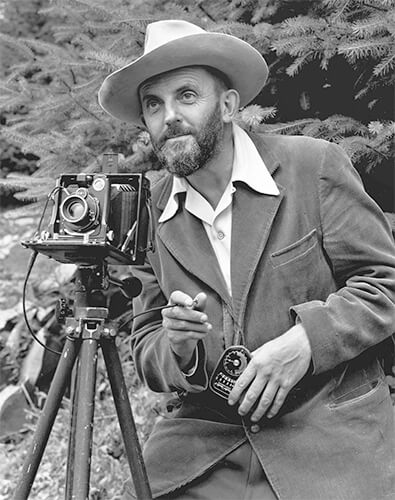Ansel Adams was an American landscape photographer and environmentalist known for his black-and-white images of the American West. He helped found Group f/64, an association of photographers advocating "pure" photography which favored sharp focus and the use of the full tonal range of a photograph. He and
Fred Archer developed an exacting system of image-making called the Zone System, a method of achieving a desired final print through a deeply technical understanding of how tonal range is recorded and developed during exposure, negative development, and printing. The resulting clarity and depth of such images characterized his photography.
Adams was a life-long advocate for environmental conservation, and his photographic practice was deeply entwined with this advocacy. At age 12, he was given his first camera during his first visit to Yosemite National Park. He developed his early photographic work as a member of the Sierra Club. He was later contracted with the United States Department of the Interior to make photographs of national parks. For his work and his persistent advocacy, which helped expand the National Park system, he was awarded the Presidential Medal of Freedom in 1980.
Adams was a key advisor in establishing the photography department at the
Museum of Modern Art in New York, an important landmark in securing photography's institutional legitimacy. He helped to stage that department's first photography exhibition, helped found the photography magazine
Aperture, and co-founded the
Center for Creative Photography at the University of Arizona.
In his autobiography, Adams expressed his concern about Americans' loss of connection to nature in the course of industrialization and the exploitation of the land's natural resources. He stated, "We all know the tragedy of the dustbowls, the cruel unforgivable erosions of the soil, the depletion of fish or game, and the shrinking of the noble forests. And we know that such catastrophes shrivel the spirit of the people... The wilderness is pushed back, man is everywhere. Solitude, so vital to the individual man, is almost nowhere."
Source: Wikipedia
To photograph truthfully and effectively is to see beneath the surfaces and record the qualities of nature and humanity which live or are latent in all things. -- Ansel Adams
American photographer and environmentalist known for his black and white photographs of the American West in Sierra Nevada and in Yosemite National Park.
Ansel Easton Adams was born in 1902 in an upper-class family. His family migrated from Ireland in the early 1700s. He was the only child of Charles and Olive Adams. His paternal grandfather founded a successful lumber business, which was later run by Ansel’s father. His mother’s family came from Baltimore. His maternal grandfather had a successful Freight-Hauling business, but squandered his wealth in numerous investment ventures. His nose was broken and scared during the San Francisco earthquake of 1906 as an aftershock threw him up against a wall. After the death of his grandfather the family business was hit by the bank crisis of 1907 and by 1912, his family’s standard of living had been dearly impacted.
Ansel was a hyperactive child prone to sickness. After being expelled from several schools due to his restlessness, at age 12, his father decided to tutor him at home with the help of professors and Ansel’s aunt. He soon became interested in music and started learning the piano, but all changed when aged 14, his aunt gave him a copy of
“In the Heart of the Sierras”. The photographs by
Georges Fiske were a revelation and Ansel persuaded his parents to visit Yosemite National Park during the following vacations. Equiped with a
Kodak Box Brownie n°1, Ansel Adams first visited Yosemite National Park in 1916. Amazed by the site and the light, he returned to Yosemite National Park the following year with better cameras and a tripod. He will return regularly to Yosemite National Park where he will even meet his future wife, Virginia Best.
You don’t take a photograph, you make it. -- Ansel Adams
At age 17, Adams joined the
Sierra Club, a wildlife preservation group. He will remain a convinced environmentalist and a member of the Sierra Club his entire life. His work will promote the goals of the Sierra Club and bring environmental issues to light. In 1932, Adams founded the group f/64 with photographer friend
Edward Weston, to promote their independent and modernist vision of photography. It is with Fred Archer that Adams will develop the Zone System (1939-40), a technique which allows photographers to define the proper exposure on negatives and adjust the contrasts on the prints. The depth and clarity of Ansel Adam’s photographs illustrate this technique. Initially, despite their size and weight, Ansel Adams used large format cameras as they offered a high resolution and a sharp image.
The timeless photographs and the striking visual beauty clearly characterize Ansel Adams’ photographs. In 1952, he was also one of the founders of
Aperture magazine. He died in 1984 from a cardio Vascular disease. Shortly after his death in 1984, the Minarets Wilderness in the Inyo National Forest was renamed the Ansel Adams Wilderness. In 1985, a peak in Sierra Nevada, was named Mount Ansel Adams. He was survived by his wife, two children and 5 grand children.
Source: The Ansel Adams Gallery
